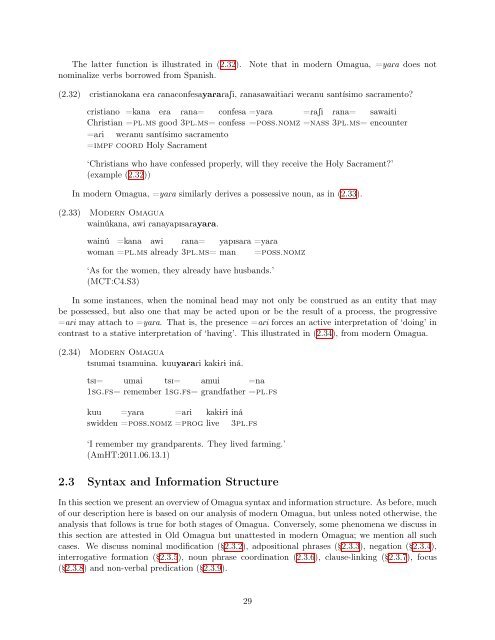draft manuscript - Linguistics - University of California, Berkeley
draft manuscript - Linguistics - University of California, Berkeley
draft manuscript - Linguistics - University of California, Berkeley
You also want an ePaper? Increase the reach of your titles
YUMPU automatically turns print PDFs into web optimized ePapers that Google loves.
The latter function is illustrated in (2.32).<br />
nominalize verbs borrowed from Spanish.<br />
Note that in modern Omagua, =yaRa does not<br />
(2.32) cristianokana eRa RanaconfesayaRaRaSi, RanasawaitiaRi weRanu santísimo sacramento?<br />
cristiano =kana eRa Rana= confesa =yaRa =RaSi Rana= sawaiti<br />
Christian =pl.ms good 3pl.ms= confess =poss.nomz =nass 3pl.ms= encounter<br />
=aRi<br />
=impf<br />
weRanu<br />
coord<br />
santísimo sacramento<br />
Holy Sacrament<br />
‘Christians who have confessed properly, will they receive the Holy Sacrament?’<br />
(example (2.32))<br />
In modern Omagua, =yaRa similarly derives a possessive noun, as in (2.33).<br />
(2.33) Modern Omagua<br />
wainúkana, awi RanayapIsaRayaRa.<br />
wainú =kana awi Rana= yapIsaRa =yaRa<br />
woman =pl.ms already 3pl.ms= man =poss.nomz<br />
‘As for the women, they already have husbands.’<br />
(MCT:C4.S3)<br />
In some instances, when the nominal head may not only be construed as an entity that may<br />
be possessed, but also one that may be acted upon or be the result <strong>of</strong> a process, the progressive<br />
=aRi may attach to =yaRa. That is, the presence =aRi forces an active interpretation <strong>of</strong> ‘doing’ in<br />
contrast to a stative interpretation <strong>of</strong> ‘having’. This illustrated in (2.34), from modern Omagua.<br />
(2.34) Modern Omagua<br />
tsIumai tsIamuina. kuuyaRaRi kak1R1 iná.<br />
tsI= umai tsI= amui =na<br />
1sg.fs= remember 1sg.fs= grandfather =pl.fs<br />
kuu =yaRa =aRi kak1R1 iná<br />
swidden =poss.nomz =prog live 3pl.fs<br />
‘I remember my grandparents. They lived farming.’<br />
(AmHT:2011.06.13.1)<br />
2.3 Syntax and Information Structure<br />
In this section we present an overview <strong>of</strong> Omagua syntax and information structure. As before, much<br />
<strong>of</strong> our description here is based on our analysis <strong>of</strong> modern Omagua, but unless noted otherwise, the<br />
analysis that follows is true for both stages <strong>of</strong> Omagua. Conversely, some phenomena we discuss in<br />
this section are attested in Old Omagua but unattested in modern Omagua; we mention all such<br />
cases. We discuss nominal modification (§2.3.2), adpositional phrases (§2.3.3), negation (§2.3.4),<br />
interrogative formation (§2.3.5), noun phrase coordination (2.3.6), clause-linking (§2.3.7), focus<br />
(§2.3.8) and non-verbal predication (§2.3.9).<br />
29
















